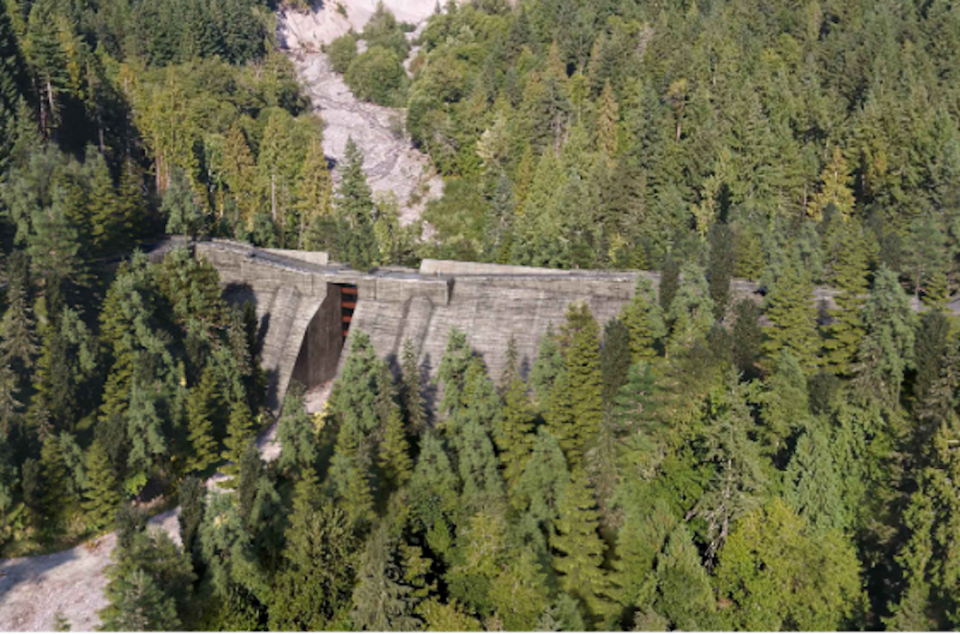A new public hearing about the Cheekye Fan debris barrier and neighbourhood is on its way, with aims to address new information about funding for post-disaster restoration.
In order for the public hearing to go ahead, Squamish council needed to rescind the third reading of a couple of bylaws related to the Cheekye River neighbourhood development, which they did in a unanimous vote on April 30.
The neighbourhood development is an enormous mixed-use project located around Ross Road near Don Ross Middle School. It is a project from proponent Sqomish Sea to Sky Developments, a partnership between Matthews West and the Sḵwx̱wú7mesh Úxwumixw (Squamish Nation).
The neighbourhood is contingent on constructing a 200-metre-long debris barrier that straddles the Cheekye River, just south of Cat Lake. The barrier was a condition imposed by the council of the day in 2018 and the barrier’s design was OK’d by an independent panel of experts about a year ago.
At the April 30 meeting, the senior director of community development, Jonas Velaniskis, told council that the new public hearing is coming about largely to address new information about finances for the operation of the debris barrier and post-disaster restoration. Additionally, Velaniskis noted the last public hearing on the project was in 2018, so a lot of time has passed since council has heard from the public.
“Procedurally, we have to hold a public hearing in order to move these bylaws forward,” he said.
Velaniskis elaborated that it is recommended that the public hearing simply addresses new information and avoid reopening negotiations on community amenity contributions or things of that nature.
The new financial information at hand is that insurance is no longer seen as a viable option to manage financial risk for post-disaster restoration, which was presented as an option in 2018. This was also recently relayed to council at a committee of the whole meeting on March 19.
“Insurance is assessed year-to-year and, therefore, not guaranteed over the long-term. In addition, due to the highly specialized insurance product that would be required, the pool of insurers is small, which increases the risk of insurance not being available over the long-term,” reads the staff report to council. “Staff … have determined that insurance is not a viable option for managing financial risk and as such, the funding model utilized in 2018 should no longer be considered a viable option.”
The funding for a post-disater restoration is still being investigated, yet Velaniskis said staff are currently planning for the public hearing to occur by the end of May.
Mayor Armand Hurford called the move an “appropriate step” in the process, and other councillors also supported it.
Coun. Andrew Hamilton said it felt a little like a step back, but hoped they could quickly move ahead after this move.
“I hope it’s one step back with two steps quickly forward,” he said.
Nation 'actively collaborating'
In a written statement sent to The Squamish Chief, Nation councillor and spokesperson, Sxwixwtn Wilson Williams, said advancing the project and barrier swiftly is crucial due to the risk associated with debris flow.
“Sqomish Sea to Sky Developments has allocated over $150 million to this vital infrastructure project. The Squamish Nation is actively collaborating with various government levels to advance this project and support the District of Squamish in expediting its decision-making processes,” he said.
“Construction must begin this summer to ensure the safety and well-being of our communities. Delaying action could lead to catastrophic outcomes. We must unite to address this pressing challenge promptly.”
In March, Velaniskis shared with council some details from a draft of the land development agreement for the neighbourhood.
Overall, the neighbourhood would be capped at 1,215 total residential units, with certain affordable and market rental units needing to be hit at various unit marks. Other stipulations in the works included child care, a no-gas covenant for residential, a commitment to transfer of ownership of Brackendale Farmers Institute Park to the District, a $1.5 million cash contribution, Ray Peters Trail dedication and upgrades, and other items.
Read more about this from council’s April 30 agenda, available at squamish.ca.




